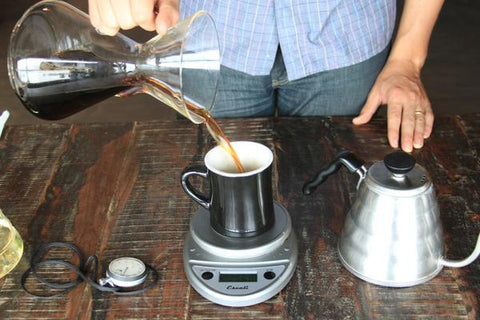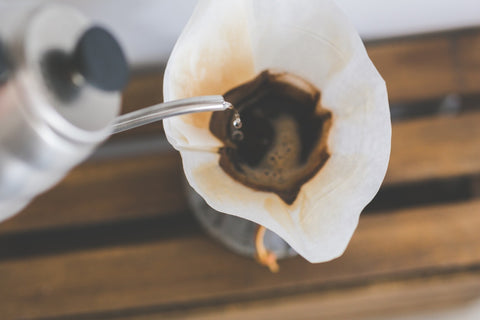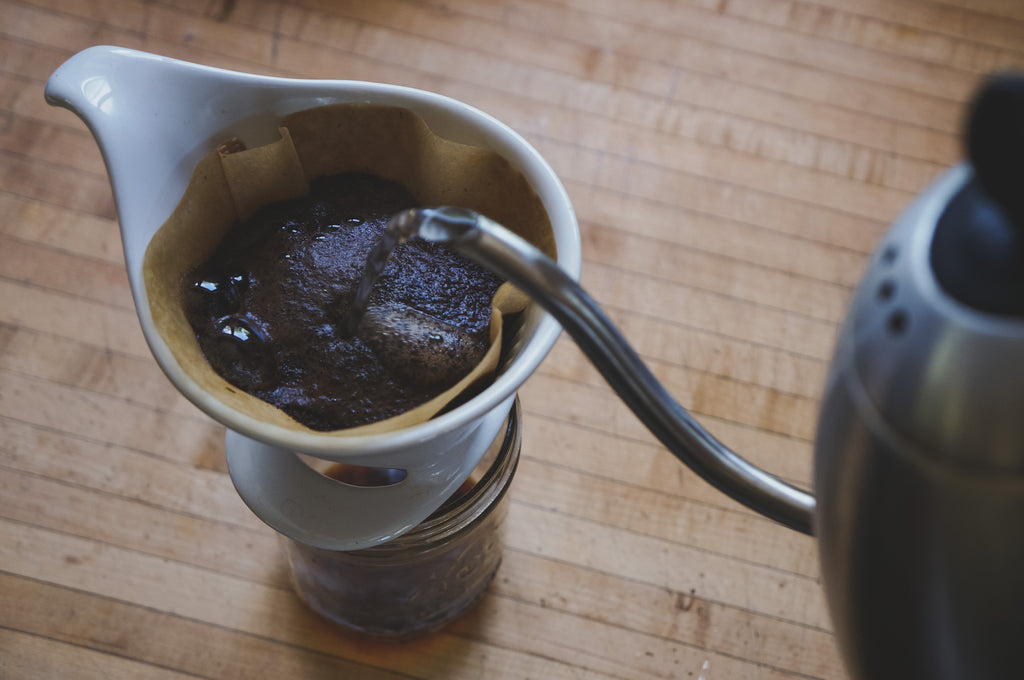Just about everyone we know starts their day with a cup of coffee. From lattes to cold brews to espressos, there are dozens of different ways to make, drink, and enjoy those little gems we call coffee beans.
With so many different styles and varieties of coffee to drink, it's not surprising that everyone has their favorite type. Not to mention their own preferred brewing method.
Today we’re talking about one of our favorite ways to brew coffee: the pour over method.
Coffee aficionados around the world prefer this brew method. Why? Because it makes a better tasting, more flavorful cup.
If you’re ready to ditch your automatic coffee maker and make pour over coffee a part of your morning routine, keep reading.
Here’s our full brew guide: how to use a pour over coffee maker.
What is Pour Over Coffee?
Pour over coffee is a drip method for brewing — but it’s different than the drip method that your automatic Mr. Coffee machine makes. Pour over coffee requires that you pour the water over your coffee beans by hand. When done properly, it makes for a more delicious cup.
Here’s why we love it:
Automatic coffee machines use internal mechanisms to flood your coffee grinds with the water in your reservoir. Once you close the lid and the machine starts working its magic, it’s out of your hands. There’s no way to control how the water hits your coffee grounds.
With pour over coffee, you control every step of the process. There’s no machine involved. There’s no option to press a button, walk away, and come back in six minutes to a piping hot cup. There’s no way to set it to brew on its own at the same time every morning.
Pour over coffee requires some work. But that’s what makes it so good.
You control everything from the temperature of the water to how the water covers your favorite grounds. It takes a bit of practice to get it right, but once you master the process, you’ll never want to drink from an automatic coffee maker again.
Related: Why You Should Try Single-Origin Coffee and How To Choose a Coffee Blend.
What You Need to Make Pour Over Coffee

A variety of retailers and well-known brands make the apparatus required to brew pour over coffee. Our preferred glass carafes are those made by Chemex.
Available in a variety of sizes to make as little as three cups or as many as ten cups. A Chemex coffee carafe is ideal for coffee lovers that have mastered the pour over brewing method or are just learning how to do it.
Here’s what you’ll need to make the perfect pour over cup:
- Chemex glass carafe
- Chemex paper filters
- Digital scale
- Burr grinder
- Filtered water
- Pour spout gooseneck kettle
And, most importantly, you’ll need some fresh coffee beans.
The amount of water and coffee grinds you use depends on how strong you want your cup, but 38 grams of coffee to 650 grams of water is usually the ideal ratio.
Learn to make cold brew too!
How to Make Pour Over Coffee
Now that you have all the essentials, here’s how to make a cup of pour over coffee:
Step 1: Boil Water
The first step in the process is to boil filtered water.
While your water is boiling, use your grinder to turn your coffee beans into a medium grind. The coarseness and grind size of your grounds will affect your overall flavor, and most people prefer a medium or finer grind.
Step 2: Prepare the Filter
Next, prepare the filter. You’ll want to place three of the four folds of a Chemex filter to the side of the carafe with the pour spout.
Before your pot of water finishes boiling, pour a little bit of water into the empty filter to seal the filter in place. Once your pot of water comes to boil, let it sit for about one minute before starting the pour over process.
Step 3: Add Coffee and Water
Add your ground coffee to the filter.
Pour 80ml of hot water directly onto the bed of coffee. You’ll see it bloom and fill the coffee filter. Let your coffee grinds bloom for about 30 seconds, then continue to pour water right into the coffee bed until you’ve used the remaining water.
How much water you add will depend on how many cups you want to make and how many beans you’ve ground.
The trick to making the perfect cup is to pour constantly. Just be careful not to fill or overfill the upper Chemex level — you want to try to keep your coffee about ½ inch from the top.
It’s also essential to make sure that you saturate every ground. You can do this by spiraling the water over the bed of coffee, taking care to soak all the grounds from around the edges of the filter.
Step 4: Brew the Coffee
You’ll see the coffee stream turn into a drip and start filling up the bottom part of your Chemex carafe. The total brew time varies depending on how much coffee you’re making, but your first cup should be ready to drink in about three to four minutes.
Once brewed, just pour it into a coffee mug and add your desired amounts of cream, milk, or sugar.
Need a quick recap to print or pin? See our Chemex step by step quick guide.
The Best Pour Over Coffee Makers

Coffee shops everywhere have seen the increasing popularity of pour over coffee in recent years. Baristas may prefer to use a French press when they have a line of customers out the door. But, without a doubt, the brew time required for pour over coffee always results in a better cup.
The Hario V60, the Kalita Wave, and the Melitta Ready Set Joe all garner high ratings and reviews as effective, affordable pour over coffee makers. But if you take your coffee as seriously as we do, we suggest sticking with the Chemex brand.
- The Chemex Glass Handle Series is one of our favorites. The carafes are sleek and elegant, unassuming, and both timeless and modern at the same time. This series is available in sizes to make anywhere from three to ten cups.
- The Chemex Classic Series is another stylish and functional option. This series boasts distinctive wood accents and colorful details and is also available in sizes ranging from three to ten cups.
- The Chemex Handblown Series looks similar to the Classic Series with wooden handles, but every carafe is hand blown. Products in this series are small-batch crafted by artisan glass blowers using Croatian glass. This series is available in sizes that range from three to thirteen cups.
Want a less hands-on drip brew? Check out the Technivorm Moccamaster!
What is it About Chemex That Makes Their Pour Over Coffee Makers so Effective?
They make each piece from non-porous Borosilicate glass. It doesn’t absorb odors or chemical residues, and it allows you to cover and refrigerate your coffee for reheating at a later time. But it’s not only the carafe that makes a difference — it’s also the filters.
Chemex coffee makers work with Chemex bonded filters, designed to make the medium-fine grind cup possible. With Chemex filters, you’ll never find sediments or bitter elements in your mug. Regardless of which Chemex coffee maker you choose, make sure you pick up the filters to go with it.
Are you interested in other brewing methods? Check out The Pros and Cons of the Electric French Press.
Pros and Cons of Pour Over Coffee
Coffee connoisseurs everywhere are big believers in the pour over method. But, like all things in life, the naysayers are always quick to point out its flaws.
Here is a roundup of the pros and cons of pour over coffee.
Pros of Pour Over Coffee
Let’s start with the good news first. There are six things about pour over coffee that make it better than automatic drip coffee. In our humble opinion, the pros heavily outweigh the cons.
1. Temperature Control
You can brew your coffee to the perfect temperature. Once you’ve boiled your water, you can let it rest and cool down for as long as you like to brew a cup at your ideal temperature. With an automatic machine, you have little to no control over the heat of your brew.
2. Price
Pour over coffee makers are less expensive than those fancy automatic machines. Without digital programming functions, timers, and complex components, a pour over carafe costs a fraction of the price.
3. Even Water Distribution
One of the most significant benefits to pour over makers is that you can control how the water covers and saturates your grounds. That means you can cover your beans evenly and equally. Standard coffee drippers often sputter and don’t soak the grounds in an even method.
4. Knowledge
Learning how to brew a cup of pour over coffee actually teaches you how to brew coffee. Adding water and pushing a button on a machine will not teach you how to perfect the brewing process.
5. Easy Clean-Up
Another big benefit is that pour over makers don't need intensive cleaningor decalcifying. All you need to do is keep your glass carafe clean, and you'll have a tasty cup every single time.
6. Space-saving
Are you tired of that multi-function drip coffee maker taking up precious real estate on your countertop? Pour over coffee makers are smaller, sleeker, and you can make a great cup even with only a tiny amount of available space.
Cons of Pour Over Coffee
The biggest complaint about pour over coffee is that it requires some manual labor. But if your goal is to brew great coffee, that’s not necessarily a bad thing.
The finer things in life always require a bit of work.
Does pour over coffee take more effort and energy than an auto-drip maker or a pod coffee machine?
Yes. But the handcrafted nature of your brew makes it all that much more rewarding.
1. Could Take More Time
Some naysayers (and some baristas) are quick to point out that it’s much more time consuming than other brewing methods. Sure, it requires more steps than pressing a button on an auto coffee machine. But the actual brewing process only takes slightly longer.
2. Filter Price
Perhaps the biggest drawback of pour over coffee is the price of the filters. For example, Chemex filters tend to be more expensive than other brands, and reusing them isn't recommended. Yet, pour over makers are much less costly than most multi-function automatic machines.
And if you’re on a quest for a high-quality cup, don’t let the cost of filters deter you from the pour over process.
If you love coffee, here's our Guide to Becoming a Coffee Connoisseur
Is Pour Over Coffee Better Than Drip Coffee?

Pour over coffee is better than drip coffee for one main reason: it generates more flavor.
The slower you pour the water, the more flavor you’ll pull out from your grounds. The more flavor you pull from those grounds, the richer and more robust your cup will be.
And while it may be slightly more labor-intensive than using an automatic drip machine, pour over coffee brewers are relatively inexpensive.
A good coffee machine can cost $200 and up, while a simple pour over maker allows you to get an even greater cup at a fraction of the price. That way, you can spend your hard-earned money on buying the best beans rather than buying the best automatic machine.
Relax and enjoy your cup with some light reading ...
Conclusion
If you’ve ever had pour over coffee, you already know that it makes for a better cup.
Haven’t tried it yet? Now is the time to get on board.
Ready to try brewing your first pour over cup?
Get yourself a small Chemex and some filters to go with it. Pick up the best beans you can find, get a coffee grinder, and take pleasure in grinding those beans yourself.
Practice making a few different cups using different water temperatures with slow pours and fast pours. Brewing coffee is like doing a science experiment — you may need to test a few different methods to make your perfect cup.
There’s only one downside to mastering the pour over brew method at home. You’ll be well on your way to becoming a coffee connoisseur. But if you’re not careful — you just might spoil yourself for others’ coffee!
